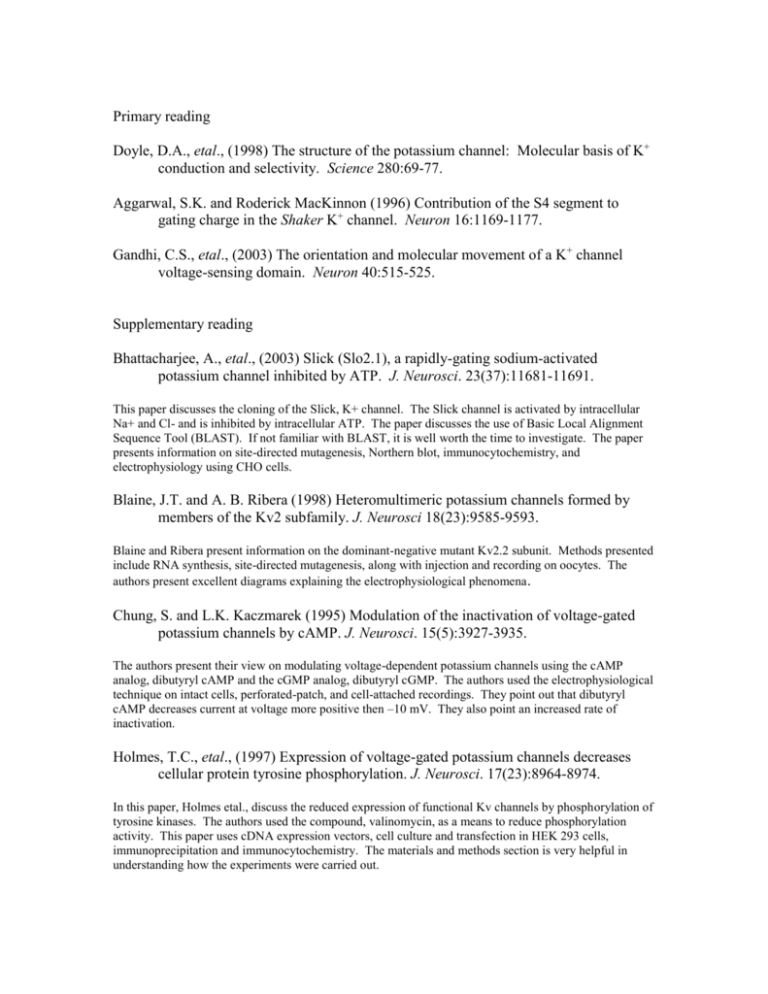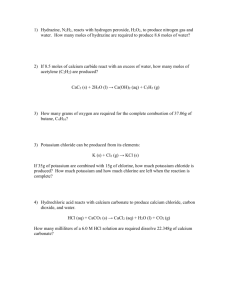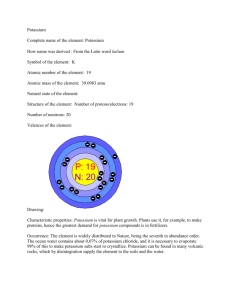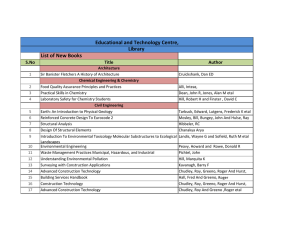Potassium Ion Channel - FSU Program in Neuroscience
advertisement

Primary reading Doyle, D.A., etal., (1998) The structure of the potassium channel: Molecular basis of K+ conduction and selectivity. Science 280:69-77. Aggarwal, S.K. and Roderick MacKinnon (1996) Contribution of the S4 segment to gating charge in the Shaker K+ channel. Neuron 16:1169-1177. Gandhi, C.S., etal., (2003) The orientation and molecular movement of a K+ channel voltage-sensing domain. Neuron 40:515-525. Supplementary reading Bhattacharjee, A., etal., (2003) Slick (Slo2.1), a rapidly-gating sodium-activated potassium channel inhibited by ATP. J. Neurosci. 23(37):11681-11691. This paper discusses the cloning of the Slick, K+ channel. The Slick channel is activated by intracellular Na+ and Cl- and is inhibited by intracellular ATP. The paper discusses the use of Basic Local Alignment Sequence Tool (BLAST). If not familiar with BLAST, it is well worth the time to investigate. The paper presents information on site-directed mutagenesis, Northern blot, immunocytochemistry, and electrophysiology using CHO cells. Blaine, J.T. and A. B. Ribera (1998) Heteromultimeric potassium channels formed by members of the Kv2 subfamily. J. Neurosci 18(23):9585-9593. Blaine and Ribera present information on the dominant-negative mutant Kv2.2 subunit. Methods presented include RNA synthesis, site-directed mutagenesis, along with injection and recording on oocytes. The authors present excellent diagrams explaining the electrophysiological phenomena . Chung, S. and L.K. Kaczmarek (1995) Modulation of the inactivation of voltage-gated potassium channels by cAMP. J. Neurosci. 15(5):3927-3935. The authors present their view on modulating voltage-dependent potassium channels using the cAMP analog, dibutyryl cAMP and the cGMP analog, dibutyryl cGMP. The authors used the electrophysiological technique on intact cells, perforated-patch, and cell-attached recordings. They point out that dibutyryl cAMP decreases current at voltage more positive then –10 mV. They also point an increased rate of inactivation. Holmes, T.C., etal., (1997) Expression of voltage-gated potassium channels decreases cellular protein tyrosine phosphorylation. J. Neurosci. 17(23):8964-8974. In this paper, Holmes etal., discuss the reduced expression of functional Kv channels by phosphorylation of tyrosine kinases. The authors used the compound, valinomycin, as a means to reduce phosphorylation activity. This paper uses cDNA expression vectors, cell culture and transfection in HEK 293 cells, immunoprecipitation and immunocytochemistry. The materials and methods section is very helpful in understanding how the experiments were carried out. Jiang, Y., etal., (2003) X-ray structure of a voltage-dependent K+ channel. Nature 423:33-41. Jiang, Y., etal., (2003) The principle of gating charge movement in a voltage-dependent K+ channel. Nature 423:42-48. These two papers work together to propose the structure and gating theory of the voltage-dependent K+ channel. The authors did an excellent job of presenting their data. Legends for figures and diagrams are explained clearly and present the data in understandable terms. The paddle theory is proposed in the second paper, but is unconvincing at this time. Liu, Y., etal., (1997) Gated access to the pore of a voltage-dependent K+ channel. Neuron 19:175-184. In this paper, the authors used the biochemical properties of the amino acid cysteine and the reactions with water-soluble thiols to determine gating properties. By binding to cysteines at different points in the pore, the thiols either blocked the pore in the open or closed state. Techniques used along with the chemical modification of the cysteines included mutagenesis and expression in HEK 293 cells and physiological recording. The discussion section of the paper provides an interesting perspective. Martina, M., etal., (2003) Properties and functional role of voltage-dependent potassium channels in dendrites of rat cerebellar Purkinje neurons. J. Neurosci. 23(13):5698-5707. In this paper the properties and functions of Kv channels located in the dendrites of Purkinje neurons were explored using the techniques of slice electrophysiology and immunocytochemistry. The authors give an excellent explanation of these techniques in the materials and methods section. Using the information provided, one should be comfortable is replicating or designing new experiments. Seoh, S-A., etal., (1996) Voltage-sensing residues in the S2 and S4 segments on the Shaker K+ channel. Neuron 16:1159-1167. The authors of this paper used a mutated construct of the Shaker channel (ShB-IR) in their efforts to determine the gating charge of the S2, S3 and S4 segments. By making substitutions in the positively and negatively charged amino acids (a neutralizing effect) it was possible to determine the direct contribution to gating charges. A number of mutations were made and each was plotted as a Q-V relationship graph. These were explained very well. The paper was a little tough to read; the second time was much better. Smart, S.L., etal., (1998) Deletion of the Kv1.1 potassium channel causes epilepsy in mice. Neuron 20:809-819. The authors point out one of the effects of a genetic mutation on the existence of mice lacking the alpha subunit of the Kv1.1 potassium channel. While epilepsy has had an influence in my personal experiences, I had never associated an ion channel with the disease. Early in the paper, generation of the Kv1.1 null mice is explained in a straightforward manner. The tables and diagrams are very good and clearly show the data. A number of techniques were used and described in the paper. These included the generation of the null mice, electroencephalography, hippocampal slice electrophysiology, flurothyl-induced seizures, and immunocytochemistry. Talley, E.M., etal., (2001) CNS distribution of members of the two-pore-domain (KCNK) potassium channel family. J. Neurosci. 21(19):7491-7505. This paper describes these channels as “leak” potassium channels. They are potassium selective and show relatively little time and voltage-dependency. These channels, found in the CNS, are a major determinant of the membrane potential and membrane input resistance in neurons. The paper describes a number of types of channels and the radioactive probes used to their expression. BioPhys Presentation 1 URL’s www.neuro.wustl.edu/neuromuscular/diagrams/chan.htm This is an excellent site for gathering background information on the ion channels, their transmitters, receptors and diseases. It has several nice diagrams. www.neuro.wustl.edu/neuromuscular/mother/chan.html This site is an alternative link for the one above. By searching the site, more information can be gained. www.hhmi.org/ This is the Howard Hughes Medical Institute site. It’s loaded with lots of neat stuff to brouse through. www.ionchannels.org This site offers just about everything for ion channels, biophysics, and electrophysiology. It has recent channel news items, job postings, top research articles, and top review articles. //scop.Berkley.edu/data/scop.b.g.bb.b.A.html This site presents information only on the voltage-gated K+ channels, includes just about all the structural information you could want. //s.webring.com/hub?ring=ionchannels This site is called the Ion Channel Web Ring. It list numerous other sites for accessing a large volume of information. Has just about everything. 25 sites listed and over 20,000 pages. //opal.msu.Montana.edu/cftr/IonChannelPrimers/beginners4.htm This site is more background information. Lots of reading, no diagrams. //faculty.Washington.edu/chudler/ap.html Good site for discussion of action potentials. Has some nice animations. //fourier.eng.hmc.edu/e180/handouts/signal1/node1.html This site is all about neural signaling and membrane potential. Excellent site for clear explanations.










